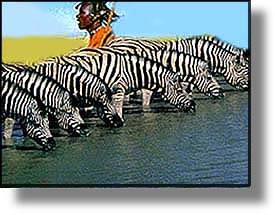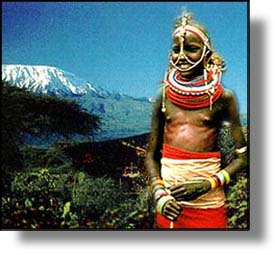
Exploring Kenya | Africa Homepage | Geographia Homepage
Location, Geography & Climate
 Kenya
is still the primary focus of all adventure travel in Africa.
It is one of the finest--and undoubtedly the most famous--safari
destination in the world. Safari, however,
is by no means the only reason to visit Kenya, for the attractions
of its rich culture and diverse environments are considerable.
Kenya
is still the primary focus of all adventure travel in Africa.
It is one of the finest--and undoubtedly the most famous--safari
destination in the world. Safari, however,
is by no means the only reason to visit Kenya, for the attractions
of its rich culture and diverse environments are considerable.
Kenya is situated right along the equator, on the eastern coast of the African continent. Its coastal region is on the southeast, and to the east lies Somalia. Ethiopia is to the north, the Sudan to the northwest, and Uganda directly to the west. The southwestern border of the country is marked by Lake Victoria, and southward lies Tanzania. Kenya's geography is marvelously varied. While much of northeastern Kenya is a flat, bush-covered plain, the remainder of the country encompasses pristine beaches, scenic highlands and lake regions, the Great Rift Valley, and the magnificent Mount Kenya.
Although Kenya's varied environments experience a wide variety of climate conditions, the temperature remains comfortably warm year-round. Much of Kenya experiences heavy rainfall from March through May and, to a lesser extent, from October through December. The best time for most outdoor acitivities (including safari and mountain climbing) is during the dry season (June-September).
History & People
 Kenya
has known the presence of humankind since the very earliest development
of our species. Moreover, the region has long been a migratory
path, passed through by wave upon wave of peoples from all over
Africa and, later, from the Middle East as well. By the 10th
century or so, the region had developed its own lingua franca,
Swahili, which is a Bantu language heavily overlaid with Arabic.
Among other familiar words, safari is Swahili, meaning
simply travel.
Kenya
has known the presence of humankind since the very earliest development
of our species. Moreover, the region has long been a migratory
path, passed through by wave upon wave of peoples from all over
Africa and, later, from the Middle East as well. By the 10th
century or so, the region had developed its own lingua franca,
Swahili, which is a Bantu language heavily overlaid with Arabic.
Among other familiar words, safari is Swahili, meaning
simply travel.
With the arrival of the Portuguese at the end of the 15th century, the East African coastal region was for a time dominated by the Europeans. However, in 1729 the Portuguese were expelled, to be replaced by two Arab dynasties. Arab rule lasted until the end of the 18th century, when Kenya passed into the British sphere of influence. The country became independent in 1963. Although it has experienced its share of internal and external strife, Kenya has in recent years been moving toward a more stable, multi-party political system.
Kenya's population is overwhelmingly (97%) comprised of people of African descent, though that group is composed of over 70 different tribal groups. Among the most significant are the Kikuyu, Kamba, Gusii, Luhya, and Luo. Kenya's primary languages are English and Swahili, though regional tribal languages abound.
Exploring Kenya | Africa Homepage
Africa | Asia | Caribbean | Europe | Latin America
Geographia Home
This page, and all contents of this Web site are Copyright (c) 1997-2007 by InterKnowledge Corp. All rights reserved.